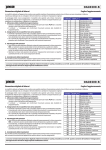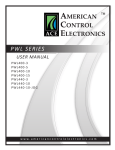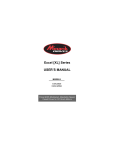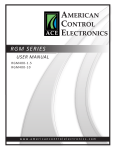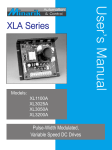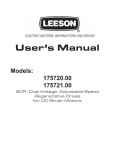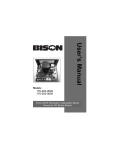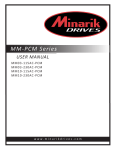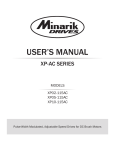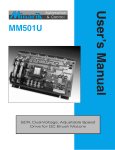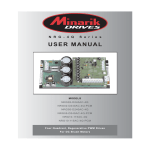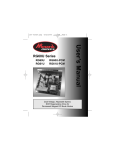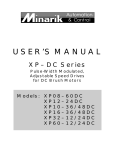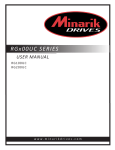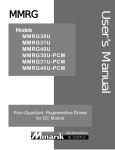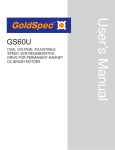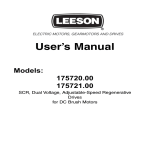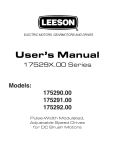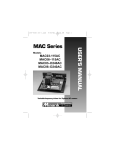Download User`s Manual - Minarik Drives
Transcript
User’s Manual XL3300A Pulse-Width Modulated, Adjustable Speed, Chassis Drive for DC Brush Motors Copyright © 2002 by Minarik Corporation All rights reserved. No part of this manual may be reproduced or transmitted in any form without written permission from Minarik Corporation. The information and technical data in this manual are subject to change without notice. Minarik Corporation and its Divisions make no warranty of any kind with respect to this material, including, but not limited to, the implied warranties of its merchantability and fitness for a given purpose. Minarik Corporation and its Divisions assume no responsibility for any errors that may appear in this manual and make no commitment to update or to keep current the information in this manual. MVD102302 Printed in the United States of America. i Safety Warnings • This symbol denotes an important safety tip or warning. SHOCK HAZARD AVOID HEAT KEE DR OID ATION Please read these instructions carefully before performing any of the procedures contained in this manual. • DO NOT INSTALL, REMOVE, OR REWIRE THIS EQUIPMENT WITH POWER APPLIED. Have a qualified electrical technician install, adjust and service this equipment. Follow the National Electrical Code and all other applicable electrical and safety codes, including the provisions of the Occupational Safety and Health Act (OSHA), when installing equipment. • Reduce the chance of an electrical fire, shock, or explosion by proper grounding, over-current protection, thermal protection, and enclosure. Follow sound maintenance procedures. It is possible for a drive to run at full speed as a result of a component failure. Minarik strongly recommends the installation of a master switch in the main power input to stop the drive in an emergency. Circuit potentials are at 115 VAC or 230 VAC above earth ground. Avoid direct contact with the printed circuit board or with circuit elements to prevent the risk of serious injury or fatality. Use a non-metallic screwdriver for adjusting the calibration trimpots. Use approved personal protective equipment and insulated tools if working on this drive with power applied. ii Contents Safety Warnings i Specifications 1 Dimensions 2 PC Board Layout 3 Installation 4 Mounting . . . . . . . . . . . . . . . . . . . . . . . . . . . . . . . . . . . . . . . . . . . . .4 Wiring . . . . . . . . . . . . . . . . . . . . . . . . . . . . . . . . . . . . . . . . . . . . . . .6 Shielding guidelines . . . . . . . . . . . . . . . . . . . . . . . . . . . . . . . . . . .7 Connections . . . . . . . . . . . . . . . . . . . . . . . . . . . . . . . . . . . . . . . . . .8 Cage-clamp terminal block . . . . . . . . . . . . . . . . . . . . . . . . . . . . .8 Field output . . . . . . . . . . . . . . . . . . . . . . . . . . . . . . . . . . . . . . . .10 Speed adjust potentiometer . . . . . . . . . . . . . . . . . . . . . . . . . . . .11 Fusing . . . . . . . . . . . . . . . . . . . . . . . . . . . . . . . . . . . . . . . . . . . .12 Voltage Follower . . . . . . . . . . . . . . . . . . . . . . . . . . . . . . . . . . . .13 Operation 14 Before applying power . . . . . . . . . . . . . . . . . . . . . . . . . . . . . . . . . .14 Startup . . . . . . . . . . . . . . . . . . . . . . . . . . . . . . . . . . . . . . . . . . . . .16 Diagnostic LEDs . . . . . . . . . . . . . . . . . . . . . . . . . . . . . . . . . . . . . .16 Starting and Stopping Methods . . . . . . . . . . . . . . . . . . . . . . . . . . .17 Calibration 22 Minimum Speed (MIN SPD) . . . . . . . . . . . . . . . . . . . . . . . . . . . . .24 Maximum Speed (MAX SPD) . . . . . . . . . . . . . . . . . . . . . . . . . . . .24 Torque Limit (TORQ LIMIT) . . . . . . . . . . . . . . . . . . . . . . . . . . . . . .25 Acceleration (ACCEL) . . . . . . . . . . . . . . . . . . . . . . . . . . . . . . . . . .26 Deceleration (DECEL) . . . . . . . . . . . . . . . . . . . . . . . . . . . . . . . . . .27 IR Compensation (IR COMP) . . . . . . . . . . . . . . . . . . . . . . . . . . . .28 JOG . . . . . . . . . . . . . . . . . . . . . . . . . . . . . . . . . . . . . . . . . . . . . . .29 Calibration with low voltage DC motors . . . . . . . . . . . . . . . . . . . . .30 iii Application Notes 31 Multiple Fixed Speeds . . . . . . . . . . . . . . . . . . . . . . . . . . . . . . . . . .31 Adjustable Speeds using Potentiometers in Series . . . . . . . . . . . .32 Independent Adjustable Speeds . . . . . . . . . . . . . . . . . . . . . . . . . .33 Leader-Follower Application . . . . . . . . . . . . . . . . . . . . . . . . . . . . .34 Single Speed Potentiometer Control of Multiple Drives . . . . . . . . . . . . . . . . . . . . . . . . . . . . . . . . . . . . . . .35 Reversing . . . . . . . . . . . . . . . . . . . . . . . . . . . . . . . . . . . . . . . . . . .36 Reversing with a DLC600 Controller . . . . . . . . . . . . . . . . . . . . . . .37 Troubleshooting 38 Before applying power . . . . . . . . . . . . . . . . . . . . . . . . . . . . . . . . .38 Block Diagrams 42 Replacement Parts 43 Certificate of Compliance 44 AC Line Filters . . . . . . . . . . . . . . . . . . . . . . . . . . . . . . . . . . . . . . .45 Unconditional Warranty inside back cover Tables Table 1. Field Output Connections . . . . . . . . . . . . . . . . . . . . . . . . . . .10 Table 2. Recommended Dynamic Brake Resistor Sizes . . . . . . . . . . .21 Table 3. Replacement Parts . . . . . . . . . . . . . . . . . . . . . . . . . . . . . . .43 Table 4. AC Line Filters . . . . . . . . . . . . . . . . . . . . . . . . . . . . . . . . . .45 iv Illustrations Figure 1. XL3300A Dimensions . . . . . . . . . . . . . . . . . . . . . . . . . . . . . .2 Figure 2. XL3300A PC Board Layout . . . . . . . . . . . . . . . . . . . . . . . . .3 Figure 3. Earth Ground Screw . . . . . . . . . . . . . . . . . . . . . . . . . . . . . . .5 Figure 4. Cage-Clamp Terminal Block . . . . . . . . . . . . . . . . . . . . . . . . .8 Figure 5. XL3300A Connections . . . . . . . . . . . . . . . . . . . . . . . . . . . . .9 Figure 6. Speed Adjust Potentiometer . . . . . . . . . . . . . . . . . . . . . . . .11 Figure 7. Voltage Follower Connections . . . . . . . . . . . . . . . . . . . . . .13 Figure 8. Voltage Selector Switches . . . . . . . . . . . . . . . . . . . . . . . . .15 Figure 9. Inhibit Pins . . . . . . . . . . . . . . . . . . . . . . . . . . . . . . . . . . . . .18 Figure 10. Run/Decelerate to Minimum Speed Switch . . . . . . . . . . . .19 Figure 11. Run/Decelerate to Zero Speed Switch . . . . . . . . . . . . . . .20 Figure 12. Calibration Trimpot Layout . . . . . . . . . . . . . . . . . . . . . . . .23 Figure 13. XL3300A TORQ. LIMIT and IR COMP Settings . . . . . . . .29 Figure 14. XL3300A MAX SPD Settings for Low Voltage DC Motors .30 Figure 15. Multiple Fixed Speeds . . . . . . . . . . . . . . . . . . . . . . . . . . .31 Figure 16. Adjustable Fixed Speeds Using Potentiometers in Series .32 Figure 17. Independent Adjustable Speeds . . . . . . . . . . . . . . . . . . . .33 Figure 18. Independent Forward and Reverse Speeds . . . . . . . . . . . .34 Figure 19. Single Speed Potentiometer Control of Multiple Drives . . .35 Figure 20. Independent Forward and Reverse Speeds . . . . . . . . . . . .36 Figure 21. Independent Forward and Reverse Speeds . . . . . . . . . . . .37 Figure 22. XL3300A Block Diagram . . . . . . . . . . . . . . . . . . . . . . . . .42 1 Specifications Type AC Line Voltage open chassis 115 VAC / 230 vac, ±10%, 50/60 Hz, single phase Line Fuse Rating Horsepower Range @ 130 VDC Output Horsepower Range @ 240 VDC Output 25A, fast acting 1/4 - 1 1/2 HP 1/4 - 3 HP Maximum Armature Voltage Range @ 115 VAC Input 45 - 130 VDC Maximum Armature Voltage Range @ 230 VAC Input 45 - 260 VDC Minimum Speed Adjustment Range @ 115 VAC Input 0 - 120 VDC Minimum Speed Adjustment Range @ 230 VAC Input 0 - 120 VDC Maximum Armature Current 13 ADC Field Voltage @ 115 VAC Input 50 VDC / 100 VDC Field Voltage @ 230 VAC Input 100 VDC / 200 VDC Maximum Field Current Form Factor 1 ADC 1.05 Acceleration Time Range (no load) for 0 - 130 VDC Armature Voltage Range 1 - 9 seconds for 0 - 240 VDC Armature Voltage Range 1 - 15 seconds Deceleration Time Range (no load) for 0 - 130 VDC Armature Voltage Range 1 - 10 seconds for 0 - 240 VDC Armature Voltage Range 1 - 18 seconds Analog Input Voltage Range (isolated signal; S1 to S2) for 0 - 130 VDC Armature Voltage Range 0 - 2.5 VDC for 0 - 240 VDC Armature Voltage Range 0 - 5.0 VDC Speed Adjust Potentiometer 10K ohms Approximate Input Impedance (from S1 to S2) 50K ohms Speed Regulation (at base speed) Ambient Operating Temperature Range Vibration 0.5% 10º - 40ºC 0.5G max. (0 - 50 Hz) 0.1G max. (above 50 Hz) . 2 Dimensions BR+ C508 BRR503 AC -BUS BUS TH501 R501 C507 T501 A1 C506 9.78 [248] 7.00 [178] LIMIT PS2 PS4 PS1 S PS PS3 C505 0.19 [5] G 115 F+ A1 F- A2 A2 1.39 [35] 1.39 [35] 6.30 [160] 6.90 [175] 3.92 [99] 0.13 [3] ALL DIMENSIONS IN INCHES [MILLIMETERS] MOUNTING SLOTS 0.19 X 3.4 [5 X 9] Figure 1. XL3300A Dimensions Dimensions PC Board Layout BRC508 BR+ AC1 R503 AC2 -BUS +BUS TH501 R501 C507 T501 SW501 VOLTAGE SELECTION SWITCHES A1 C506 C502 IC502 "POWER ON" and "CURRENT LIMIT" LEDs POWER ON PS2 PS4 PS1 PS3 2-PIN CONNECTORS (POWER, CURR, and +15 used on future drives). C504 IC501 CURR LIMIT IL501 IL502 C505 POWER CURR +15 INHIBIT CALIBRATION TRIMMER POTENTIOMETERS FUSE HOLDERS FUSE HOLDERS S1 S2 S3 SPD TB501 SPEED ADJUST POTENTIOMETER TERMINALS L1 230 115 JOG A2 IN F- A2 SPD, PD IN, and JOG TERMINALS CAGE-CLAMP TERMINAL BLOCK Figure 2. XL3300A PC Board Layout 3 4 Installation Mounting Warning Do not install, rewire, or remove this control with input power applied. Doing so may cause fire or serious injury. Make sure you have read and understood the Safety Warnings on page i before attempting installation. • Drive components are sensitive to electrostatic fields. Avoid direct contact with the circuit board. Hold drive by the chassis only. • Protect the drive from dirt, moisture, and accidental contact. • Provide sufficient room for access to the terminal block and calibration trimpots. The minimum enclosure size for the XL3300A is six cubic feet. • Mount the drive away from heat sources. Operate the drive within the specified ambient operating temperature range. • Prevent loose connections by avoiding excessive vibration of the drive. • Mount drive with its board in either a horizontal or vertical plane. Four 0.19 inch (5 mm) wide slots in the chassis accept #8 pan head screws. • Connect earth ground to the green earth ground screw attached to the heat sink. See Figure 3 (page 5) for the earth ground screw location. Installation EARTH GROUND SCREW BRC508 BR+ AC1 R503 AC2 -BUS +BUS TH501 R501 C507 T501 SW501 A1 C506 C502 IC502 IC501 C504 Figure 3. Earth Ground Screw 5 6 Installation Wiring Warning Do not install, remove, or rewire this equipment with power applied. Failure to heed this warning may result in fire, explosion, or serious injury. Circuit potentials are at 115 or 230 VAC above ground. To prevent the risk of injury or fatality, avoid direct contact with the printed circuit board or with circuit elements. Do not disconnect any of the motor leads from the drive unless power is removed and the drive is disabled. Opening any one motor lead may destroy the drive. • Use 18 AWG wire for speed adjust potentiometer wiring. Use 16 AWG wire for field (F1, F2) wiring. Use 14 AWG wire for AC line (L1, L2) and motor (A1, A2) wiring. Installation 7 Shielding guidelines Warning Under no circumstances should power and logic leads be bundled together. Induced voltage can cause unpredictable behavior in any electronic device, including motor controls. As a general rule, Minarik recommends shielding of all conductors. If it is not practical to shield power conductors, Minarik recommends shielding all logic-level leads. If shielding logic leads is not practical, the user should twist all logic leads with themselves to minimize induced noise. It may be necessary to earth ground the shielded cable. If noise is produced by devices other than the drive, ground the shield at the drive end. If noise is generated by a device on the drive, ground the shield at the end away from the drive. Do not ground both ends of the shield. If the drive continues to pick up noise after grounding the shield, it may be necessary to add AC line filtering devices, or to mount the drive in a less noisy environment. 8 Installation Connections Cage-clamp terminal block XL3300A connections are made to a cage-clamp terminal block (Figure 4). To insert a wire into the terminal block, press down on the lever arm using a small screwdrive. Insert stripped wire into the large opening in front of the terminal block. Release the lever arm to clamp the wire. LEVER ARM Figure 4. Cage-Clamp Terminal Block Installation JOG TRIMMER POT SPD and SPD IN are prewired for speed adjust potentiometer control. To control speed with a JOG trimmer potentiometer, connect SPD IN to JOG. Motor will not turn if there is no connection to SPD IN. SPD SPD JOG IN TB501 L1 230 115 F+ A1 F- A2 MOTOR 230 VAC ARMATURE OUTPUT 115 VAC AC LINE VOLTAGE (115 or 230 VAC) FIELD OUTPUT Shunt wound motors only. See Field Output section for connections Figure 5. XL3300A Connections 9 10 Installation Field output The field output is for shunt wound motors only. Do not make any connections to the field output when using a permanent magnet motor. Table 1 shows where to connect the field leads of a shunt wound motor. Table 1. Field Output Connections Line Voltage (VAC) Approximate Field Voltage (VDC) XL3300A Field Connections 115 50 F+ and L1 115 100 F+ and F- 230 100 F+ and L1 230 200 F+ and F- Use 18 AWG wire to connect the field output to a shunt wound motor. Installation 11 Speed adjust potentiometer Install the circular insulating disk between the panel and the 10K ohm speed adjust potentiometer. Mount the speed adjust potentiometer through a 0.38 inches (10 mm) hole with the hardware provided (Figure 6). Twist the speed adjust potentiometer wire to avoid picking up unwanted electrical noise. If potentiometer leads are longer than 18 inches (457 mm), use shielded cable. Ground only one end of the shield. MOUNT THROUGH A 0.38 IN. (10 MM) HOLE CW WIPER W NUT STAR WASHER SPEED ADJUST POTENTIOMETER INSULATING DISK PANEL Figure 6. Speed Adjust Potentiometer 12 Installation Fusing The XL3300A has three 25A, fast-acting fuses installed (FU501 FU503). FU501 connects with the L1 terminal (the hot leg of the AC line voltage). FU502 connects with the 230 terminal. FU503 connects with the A2 terminal to protect the motor from related conditions not protected by the AC line fuses. If the horsepower rating of the motor is less than the maximum horsepower rating of the drive, replace the fuse with a lower rated one. Rate fuses at 150% times the maximum armature current. Installation 13 Voltage Follower Instead of using a speed adjust potentiometer, the drive may be wired to follow an analog input voltage that is isolated from earth ground. Connect the signal input (+) to S2 and the signal common (-) to S1 (Figure 7). Make no connection to S3. A potentiometer can be used to scale the analog input voltage if needed. To achieve greater linearity and control, use an interface device such as a Minarik model PCM4 to scale the analog input voltage. Signal Common - S1 L1 MI TB501 115 F+ S1 Signal Input 230 S2 S2 0 - 5 VDC for 0 - 240 VDC armature voltage range. Figure 7. Voltage Follower Connections JOG A2 VDC armature voltage range, and ACCEL A2 range is 0 - 2.5 VDC for 0 - 130 SPD SPD JOG IN F- NOTE: The analog input voltage S3 A1 + 14 Operation Before applying power Warning Change voltage selection switch settings only when the drive is disconnected from the AC line voltage. Make sure both switches are set to their correct position. If the switches are improperly set to a lower voltage position, the motor will not run at full voltage. If the switches are improperly set to a higher voltage position, the motor will overspeed, which may cause motor damage. • Verify that no conductive material is present on the printed circuit board. • Set both voltage selection switches (SW501 and SW502) to either 115 or 230 to match the AC line voltage being used. See Figure 8 (page 16). Operation AC1 SW501 BR+ IC502 T501 230 115 CURR LIMIT 230 +BUS IC501 115 C508 TH501 R501 A1 R503 C507 -BUS C506 Figure 8. Voltage Selector Switches BR- SW502 AC2 C502 SW501 15 16 Operation Startup 1. Turn the speed adjust potentiometer full counterclockwise (CCW). 2. Apply AC line voltage. 3. Slowly advance the speed adjust potentiometer clockwise (CW). The motor slowly accelerates as the potentiometer is turned CW. Continue until the desired speed is reached. 4. Remove AC line voltage from the drive to coast the motor to a stop. If the motor or drive does not perform as described, disconnect the AC line voltage immediately. Refer to the Troubleshooting section on page 40 for further assistance. Diagnostic LEDs XL3300A drives are equipped with the following diagnostic LEDs: • The green POWER ON LED turns on when power is applied to the drive and turns off when power is removed. • The red CURR LIMIT LED turns on when the drive reaches current limit and turns off when the drive is not in current limit (normal operation). Operation 17 Starting and Stopping Methods Line starting and line stopping Line starting and line stopping (applying and removing AC line voltage) is recommended for infrequent starting and stopping of a drive only. When AC line voltage is applied to the drive, the motor accelerates to the speed set by the speed adjust potentiometer. When AC line voltage is removed, the motor coasts to a stop. Inhibit circuit Warning The inhibit circuit is used for frequent starts and stops. It must never be used as an emergency stop. It may not stop a drive that is malfunctioning. Removing AC line power (both L1 and L2) is the only acceptable method for emergency stopping. The XL3300A has an inhibit circuit that causes the motor to coast to zero speed when the inhibit pins are shorted together. Removing the connection between the inhibit pins allows the motor to accelerate to the speed set by the speed adjust potentiometer (see Figure 9, page 19). Operation BRBR+ AC1 C508 18 R503 AC2 -BUS +BUS TH501 R501 C507 T501 SW501 A1 C506 C502 IC502 C504 IC501 POWER ON PS2 PS4 PS1 PS3 INHIBIT PINS CURR LIMIT IL501 IL502 C505 POWER CURR S1 +15 S2 INHIBIT S3 SPD L1 230 115 JOG A2 IN TB501 F- A2 Figure 9. Inhibit Pins Minarik Corporation offers two accessory plug harnesses for connecting to the inhibit pins: part number 201-0024 [inhibit plug with 18 in. (46 cm) leads]; and part number 201-0079 [inhibit plug with 36 in. (91 cm) leads]. Twist these leads and separate them from other power-carrying wires or sources of electrical noise. Use shielded cable if the inhibit leads are longer than 18 in. (46 cm). If shielded cable is used, ground only one end of the shield to earth ground. Do not ground both ends of the shield. Operation 19 Decelerating to minimum speed The circuit shown in Figure 10 may be used to decelerate a motor to a minimum speed. Closing the switch between S1 and S2 decelerates the motor from set speed to a minimum speed determined by the MIN SPD trimpot setting. If the MIN SPD trimpot is set full CCW, the motor decelerates to zero speed when the switch between S1 and S2 is closed. The DECEL trimpot setting determines the rate at which the drive decelerates. By opening the switch, the motor accelerates to set speed at a rate determined by the ACCEL trimpot setting. CW S3 10K OHM SPEED ADJUST POTENTIOMETER S2 S1 RUN DECEL TO MIN SPEED Figure 10. Run/Decelerate to Minimum Speed Switch 20 Operation Dynamic braking Dynamic braking may be used to rapidly stop a motor (Figure 11). For the RUN/BRAKE switch, use a double-pole, double-throw switch rated for at least the maximum DC armature voltage and maximum braking current. A1 A2 RUN MOTOR DYNAMIC BRAKE RESISTOR BRAKE INHIBIT Figure 11. Run/Decelerate to Zero Speed Switch Operation 21 Size the dynamic brake resistor according to the motor current rating (see Table 2). The dynamic brake resistance listed in the table is the smallest recommended resistance allowed to prevent possible demagnetization of the motor. The motor stops less rapidly with higher brake resistor values. Table 2. Recommended Dynamic Brake Resistor Sizes Motor Armature Current Rating (ADC) Minimum Dynamic Brake Resistor Value (Ohms) Minimum Dynamic Brake Resistor Power (Watts) 5 - 10 20 20 10 - 17 40 50 22 Calibration Warning Dangerous voltages exist on the drive when it is powered. When possible, disconnect the voltage input from the drive before adjusting the trimpots. If the trimpots must be adjusted with power applied, use insulated tools and the appropriate personal protection equipment. BE ALERT. High voltages can cause serious or fatal injury. Each drive is factory calibrated to its maximum horsepower rating. Readjust the calibration trimpot settings to accommodate lower current rated motors. All adjustments increase with CW rotation, and decrease with CCW rotation. Use a non-metallic screwdriver for calibration. Each trimpot is identified on the printed circuit board. See Figure 12 (page 24) for trimmpot locations. Calibration MAX SPD TORQ. LIMIT PS2 PS4 IL501 23 IR COMP IL502 C505 PS1 +15 PS3 S1 S2 JOG L1 MIN SPD 230 115 DECEL F+ A2 IN TB501 A1 F- A2 ACCEL Figure 12. Calibration Trimpot Layout JOG 24 Calibration Minimum Speed (MIN SPD) The MIN SPD setting determines the motor speed when the speed adjust potentiometer is turned full CCW. It is factory set for minimum rated speed. To calibrate, set the MIN SPD trimpot full CCW. Turn the speed adjust potentiometer full CCW. Adjust the MIN SPD trimpot until the desired minimum motor speed is reached. Maximum Speed (MAX SPD) The MAX SPD setting determines the motor speed when the speed adjust potentiometer is turned full CW. It is factory set for maximum rated speed. To calibrate, set the MAX SPD trimpot full CCW. Turn the speed adjust potentiometer full CW. Adjust the MAX SPD trimpot until the desired maximum motor speed is reached. Calibration 25 Torque Limit (TORQ LIMIT) Warning TORQ. LIMIT should be set to 120% of motor nameplate current rating. Continuous operation beyond this rating may damage the motor. If you intend to operate beyond the rating, contact your Minarik representative for assistance. The TORQ. LIMIT setting determines the maximum armature current output of the drive. It is factory set at 120% of rated motor current. Recalibrate the TORQ. LIMIT setting when using a lower horsepower motor. Refer to Figure 13 (page 30) for approximate TORQ. LIMIT settings, or recalibrate using the following procedure: 1. With the power disconnected from the control, connect a DC ammeter (0 - 15 minimum scale) in series with the armature. 2. Set the TORQ. LIMIT trimpot to minimum (full CCW). 3. Set the speed adjust potentiometer to maximum speed (full CW). 4. Carefully lock the motor armature. Be sure that the motor is firmly mounted. 5. Apply line power. The motor should be stopped. 6. Slowly adjust the TORQ. LIMIT trimpot CW until the armature current is 120% of motor rated armature current. 7. Turn the speed adjust potentiometer CCW until the motor stops. 8. Remove the line power. 9. Remove the stall from the motor. 10. Remove the ammeter in series with the motor armature if it is no longer needed. 26 Calibration Acceleration (ACCEL) The ACCEL setting determines the time the motor takes to ramp to a higher speed. See Specifications on page 1 for approximate acceleration times. ACCEL is factory set to its minimum value (full CCW). Use the following procedure to set the acceleration time: 1. Set the speed adjust potentiometer full CCW. The motor should run at minimum speed (as set by the MIN SPD trimpot, page 25). 2. Turn the speed adjust potentiometer full CW and measure the time it takes the motor to go from minimum to maximum speed. 3. If the time measured in step 2 is not the desired acceleration time, turn the ACCEL trimpot CW for a slower acceleration time, or CCW for a faster acceleration time. Repeat steps 1 through 3 until the acceleration time is correct. Calibration 27 Deceleration (DECEL) The DECEL setting determines the time the motor takes to ramp to a lower speed. See Specifications on page 1 for approximate deceleration times. DECEL is factory set for the fastest deceleration time (full CCW). Use the following procedure to set the deceleration time: 1. Set the speed adjust potentiometer full CW. The motor should run at maximum speed (as set by MAX SPD trimpot, page 25). 2. Turn the speed adjust potentiometer full CCW and measure the time it takes the motor to go from maximum to minimum speed. 3. If the time measured in step 2 is not the desired deceleration time, turn the DECEL trimpot CW for a slower deceleration time, or CCW for a faster deceleration time. Repeat steps 1 through 3 until the deceleration time is correct. 28 Calibration IR Compensation (IR COMP) The IR COMP trimpot setting determines the degree to which motor speed is held constant as the motor load changes. It is factory set for optimum motor regulation. Recalibrate the IR COMP setting when using a lower current rated motor. Refer to Figure 13 (page 30) for approximate IR COMP settings, or use the following procedure to recalibrate the IR COMP: 1. Set the IR COMP trimpot to minimum (full CCW). 2. Rotate the speed adjust potentiometer until the motor runs at midspeed without load (for example, 900 RPM for an 1800 RPM motor). A hand held tachometer may be used to measure motor speed. 3. Load the motor armature to its full load armature current rating. The motor should slow down. 4. While keeping the load on the motor, rotate the IR COMP trimpot until the motor runs at the speed measured in step 2. If the motor oscillates (overcompensation), the IR COMP trimpot may be set too high (CW). Turn the IR COMP trimpot CCW to stabilize the motor. 5. Unload the motor. Calibration 29 JOG The JOG setting determines the motor speed when the drive is set to the JOG mode. To control the speed with the JOG trimpot: 1. Connect the SPD IN and JOG terminals. 2. Calibrate the JOG trimpot until the motor runs at the desired JOG speed. TORQ LIMIT TORQ LIMIT TORQ LIMIT IR COMP 1/4 HP 90 VDC 1750 RPM 2.5 AMPS IR COMP 1/2 HP 90 VDC 1750 RPM 5 AMPS IR COMP 1 HP 90 VDC 1750 RPM 10 AMPS TORQ LIMIT TORQ LIMIT TORQ LIMIT IR COMP 1/2 HP 180 VDC 1750 RPM 2.5 AMPS IR COMP 1 HP 180 VDC 1750 RPM 5 AMPS IR COMP 2 HP 180 VDC 1750 RPM 9 AMPS Figure 13. XL3300A TORQ. LIMIT and IR COMP Settings 30 Calibration Calibration with low voltage DC motors Using XL3300A with a low voltage DC motor requires using a lower resistance speed adjust potentiometer, and recalibrating the MAX SPD trimpot settings. See Figure 14 for MAX SPD trimpot settings. NOTE: MAX SPD trimmer pot settings are approximate. Verify maximum armature voltage with a voltmeter. Care should be taken when using low voltage motors to ensure motor insulation rating is above bus voltage of the drive. MAX SPEED TRIMPOT SETTING USING 2.5K OHM SPEED ADJUST POTENTIOMETER (202-0056) USING 1.5K OHM SPEED ADJUST POTENTIOMETER (202-0001) 12 NOT APPLICABLE NOT APPLICABLE 24 NOT APPLICABLE NOT APPLICABLE MOTOR ARMATURE VOLTAGE (VDC) 36 48 Figure 14. XL3300A MAX SPD Settings for Low Voltage DC Motors 31 Application Notes Multiple Fixed Speeds Replace the speed adjust potentiometer with series resistors with a total series resistance of 10K ohms (Figure 15). Add a single-pole, multi-position switch with the correct number of positions for the desired number of fixed speeds. R1 S3 R2 S2 R3 S1 TOTAL SERIES RESISTANCE 10K OHMS R4 Figure 15. Multiple Fixed Speeds 32 Application Notes Adjustable Speeds using Potentiometers in Series Replace the speed adjust potentiometer with a single-pole, multiposition switch, and two or more potentiometers in series, with a total series resistance of 10K ohms. Figure 16 shows a connection for fixed high and low speed adjust potentiometers. CW S3 HIGH SPEED 5K OHM LOW SPEED CW S2 S1 5K OHM Figure 16. Adjustable Fixed Speeds Using Potentiometers in Series Application Notes 33 Independent Adjustable Speeds Replace the speed adjust potentiometer with a single-pole, multiposition switch, and two or more potentiometers in parallel, with a total parallel resistance of 10K ohms. Figure 17 shows the connection of two independent speed adjust potentiometers that can be mounted at two separate operating stations. S3 SPEED 2 CW CW SPEED 1 20K OHM 20K OHM S2 S1 Figure 17. Independent Adjustable Speeds 34 Application Notes Leader-Follower Application In this application, use a PCM4 to monitor the speed of the leader motor (Figure 18). The PCM4 isolates the leader motor from the follower drive, and outputs a voltage proportional to the leader motor armature voltage. The follower drive uses this voltage reference to set the speed of the follower motor. An optional ratio potentiometer may be used to scale the PCM4 output voltage. MOTOR A2 (+) 2 9 (+) A1 Leader Drive 8 PCM4 7 (-) TB501 S2 (-) 1 TB502 S1 10K Ohm (optional) Figure 18. Independent Forward and Reverse Speeds Follower Drive Application Notes 35 Single Speed Potentiometer Control of Multiple Drives Multiple drives can be controlled with a single speed adjust potentiometer using a PCM4 at the input of each drive to provide isolation (Figure 19). Optional ratio potentiometers can be used to scale the PCM4 output voltage, allowing independent control of each drive. 6 10K Ohms 8 2 1 7 TB501 Drive A S1 Motor A A2 TB502 6 8 A1 S2 PCM4 7 TB501 ratio pot A (optional) 10K Ohms 2 ratio pot B (optional) 10K Ohms A1 S2 PCM4 1 S1 Motor B Drive B A2 TB502 Figure 19. Single Speed Potentiometer Control of Multiple Drives 36 Application Notes Reversing A dynamic brake may be used when reversing the motor direction (Figure 20). Use a three-pole, three-position switch rated for at least the maximum DC armature voltage and maximum braking current. Wait for the motor to stop completely before switching it to either the forward or reverse direction. See page 22 for recommended dynamic brake resistor sizes. A1 A2 DYNAMIC BRAKE RESISTOR MOTOR FWD BRAKE REV INHIBIT Figure 20. Independent Forward and Reverse Speeds Application Notes 37 Reversing with a DLC600 Controller A DLC600 controller can be used in a reversing application. The DLC600 must be inhibited while braking. Without the inhibit feature, the DLC600 will continue to regulate. This will cause overshoot when the DLC600 is switched back to the drive. Figure 21 shows the connection of the reversing circuit to an XL3300A series drive and a DLC600. NOTE: Only one DLC option (Optical Encoder or Magnetic Pickup) may be used at a time. S3 MINARIK DRIVE A1 S2 S1 A2 Dynamic Brake Resistor S1 S2 BRAKE FWD REV DLC600 Inhibit Leads C IN Motor Common Optical Encoder Signal +5 VDC Magnetic Pickup Figure 21. Independent Forward and Reverse Speeds + 38 Troubleshooting Warning Dangerous voltages exist on the drive when it is powered. When possible, disconnect the drive while troubleshooting. High voltages can cause serious or fatal injury. Before applying power Check the following steps before proceeding: 1. Disconnect AC line voltage from the drive. 2. Check the drive closely for damaged components. 3. Check that no conductive or other foreign material has become lodged on the printed circuit board. 4. Verify that every connection is correct and in good condition. 5. Verify that there are no short circuits or grounded connections. 6. Check that the voltage selection switch settings match the AC line and output voltages. 7. Check that the drive’s rated armature and field outputs are consistent with the motor ratings. For additional assistance, contact your local Minarik distributor, or the factory direct: 1-800-MINARIK (646-2745) or Fax: 1-800-394-6334 Troubleshooting 39 Problem Possible Causes Suggested Solutions Line fuse blows. 1. Line fuse is the wrong size. 1. Check that the line fuse is correct for the motor size. 2. Motor cable or armature is shorted to ground. 2. Check motor cable and armature for shorts. 1. Speed adjust potentiometer or reference voltage is set to zero speed. 1. Increase the speed adjust potentiometer setting or reference voltage. 2. Speed adjust potentiometer or reference voltage is not connected to drive input properly; connections are open. 2. Check connections to input. Verify that connections are not open. 3. INHIBIT terminals are jumpered. 3. Remove jumper from the INHIBIT terminals. 4. S2 is shorted to S0. 4. Remove short. Line fuse does not blow, but the motor does not run. 40 Troubleshooting Problem Possible Causes Suggested Solutions Line fuse does not blow, but the motor does not run (cont.) 5. Drive is in current limit. 5. The red current limit LED must be off. If the red current limit LED is on, verify that the motor is not jammed. It may be necessary to increase the TORQ. LIMIT setting if it is set to a value lower than the current rating of the motor. 6. Drive is not receiving AC line voltage. 6. Apply AC line voltage to L1 and L2. 7. Motor is not connected. 7. Connect motor to A1 and A2. 1. MIN SPD and MAX SPD not calibrated. 1. Calibrate MIN SPD and MAX SPD . Make sure settings are not set too high. 2. Field output connections are not secure. 2. Check that the field output connections are secure if you are using a shunt wound motor Motor runs too fast at maximum speed setting Troubleshooting 41 Problem Possible Causes Suggested Solutions Motor runs in opposite direction. 1. Connections to motor armature are reversed. 1. Remove AC line voltage and reverse connections to the motor armature. Motor will not stop when the speed adjust potentiometer is full counterclockwise 1. MIN SPD is not calibrated to zero. 1. Calibrate MIN SPD trimpot to zero speed. Motor pulsates or surges under load. 1. IR COMP is set too high. 1. Adjust the IR COMP setting slightly CCW until the motor speed stabilizes. 2. Motor bouncing in and out of current limit. 2. Make sure motor is not undersized for load; adjust TORQ LIMIT trimpot CW. PS1 + PS2 A1 L1 POWER LIGHT 230 + INPUT RECTIFIER OUTPUT POWER STAGE - A2 115 PS3 CHASSIS GROUND PS4 +15 +15 115-230 +15 470 CONTROL LOGIC POWER 230-115 5K 470 MIN SPEED S3 PWM GENERATOR PEAK CURRENT DETECTOR -15 CONTROL TRANSFORMER 330K S2 POWER LED 470 S1 56K 10K SPD 51K IR COMP 20K 6.8 +15 JOG SPD terminal is prewired to SPD IN terminal. 50K CURR LIMIT SPD IN + 500K -15 50K 12K MAX SPEED JOG 0.1 12K 10K 47K CURRENT LIMIT LED 2.2K 5K 500K INHIBIT Figure 22. XL3300A Block Diagram 50K 42 FIELD SUPPLY F2 Block Diagrams + F1 43 Replacement Parts Replacement parts are available from Minarik Corporation and its distributors for this drive series. Table 3. Replacement Parts Model No. Symbol Description Minarik P/N XL3300A BR601 35A, 600V Bridge 073-0008 C505-507 680 MF, 400 VDC Capacitor 011-0080 D501 16A, 600V Diode 071-0044 Q501,502 Power Mosfet 070-0066 R501 0.01 ohm, 5W Resistor 032-0129 T501 3FD-436 Transformer 230-0072 TH501 30A, 1 ohm Thermistor 033-0009 FU501-503 20A Slow Acting Fuse 050-0063 10K ohm Potentiometer Kit 202-0003 Line Fuse Kit (1 - 8A) 050-0068 Line Fuse Kit (3 - 10A) 050-0070 Line Fuse Kit (5 - 15A) 050-0072 1/2A Pico Fuse 050-0064 44 Certificate of Compliance Minarik Corporation hereby certifies that its MMRG series drives has been approved to bear the “CE” mark provided the conditions of approval have been met by the end user. The MMRG series has been tested to the following test specifications: EN55011:1993 (emissions), and EN50082-1:1992 (immunity) Compliance allows Minarik’s XL series drives to bear the CE mark. The end user, as described herein, falls into one of two categories: 1. The Consumer will deploy a stand-alone unit as an integral, yet external, portion of the machine being operated. 2. The Original Equipment Manufacturer (OEM) will implement the product as a component of the machine being manufactured. CE Compliance 45 AC Line Filters In addition to EMI/RFI safeguards inherent in the XL series design, external filtering is required. Minarik requires the AC line filters listed in Table 4. Use model CE15XL with drives rated for 15A AC or below. Table 4. AC Line Filters Minarik Model Number Rated Current Inductance Capacitance Line to Line Line to Ground Discharge Resistor CE04XL 4A 17.5 mH 0.82 mF 0.0056 mF 330 Kohms CE10XL 10A 14.3 mH CE15XL 15A 10.0 mH 0.82 mF 0.82 mF 0.0056 mF 0.0056 mF 330 Kohms 330 Kohms Wire the AC line filter within 0.25 meters of the drive. The ground connection from the filter must be wired to solid earth ground (resistance less than 500 ohms); not machine ground. This is very important! If the end-user is using a CE-approved motor, the correct filter from Table 4 is all that is necessary to meet the EMC directirves listed herein. 46 NOTES 47 NOTES 48 NOTES Unconditional Warranty A. Warranty Minarik Corporation (referred to as "the Corporation") warrants that its products will be free from defects in workmanship and material for twelve (12) months or 3,000 hours, whichever comes first, from date of manufacture thereof. Within this warranty period, the Corporation will repair or replace, at its sole discretion, such products that are returned to Minarik Corporation, 901 East Thompson Avenue, Glendale, CA 912012011 USA. This warranty applies only to standard catalog products, and does not apply to specials. Any returns for special controls will be evaluated on a case-by-case basis. The Corporation is not responsible for removal, installation, or any other incidental expenses incurred in shipping the product to and from the repair point. B. Disclaimer The provisions of Paragraph A are the Corporation's sole obligation and exclude all other warranties of merchantability for use, express or implied. The Corporation further disclaims any responsibility whatsoever to the customer or to any other person for injury to the person or damage or loss of property of value caused by any product that has been subject to misuse, negligence, or accident, or misapplied or modified by unauthorized persons or improperly installed. C. Limitations of Liability In the event of any claim for breach of any of the Corporation's obligations, whether express or implied, and particularly of any other claim or breech of warranty contained in Paragraph A, or of any other warranties, express or implied, or claim of liability that might, despite Paragraph B, be decided against the Corporation by lawful authority, the Corporation shall under no circumstances be liable for any consequential damages, losses, or expense arising in connection with the use of, or inability to use, the Corporation's product for any purpose whatsoever. An adjustment made under warranty does not void the warranty, nor does it imply an extension of the original 12-month warranty period. Products serviced and/or parts replaced on a no-charge basis during the warranty period carry the unexpired portion of the original warranty only. If for any reason any of the foregoing provisions shall be ineffective, the Corporation's liability for damages arising out of its manufacture or sale of equipment, or use thereof, whether such liability is based on warranty, contract, negligence, strict liability in tort, or otherwise, shall not in any event exceed the full purchase price of such equipment. Any action against the Corporation based upon any liability or obligation arising hereunder or under any law applicable to the sale of equipment or the use thereof, must be commenced within one year after the cause of such action arises. 901 E Thompson Avenue Glendale, CA 91201-2011 Tel.: 1-800-MINARIK (646-2745) Fax: 1-800-394-6334 www.minarikcorp.com Document Number 250-0217, Rev. 2 Printed in the U.S.A – October 2002
























































